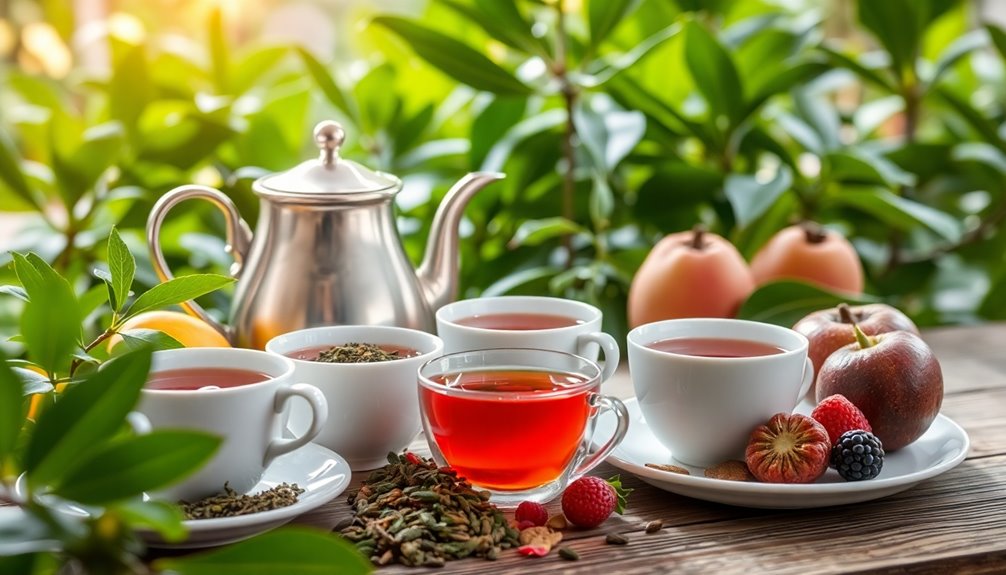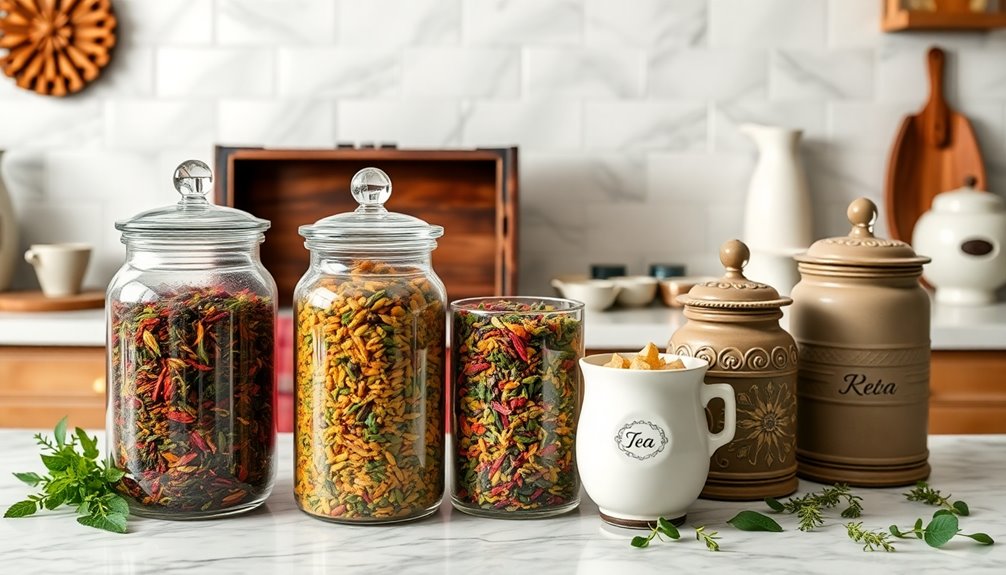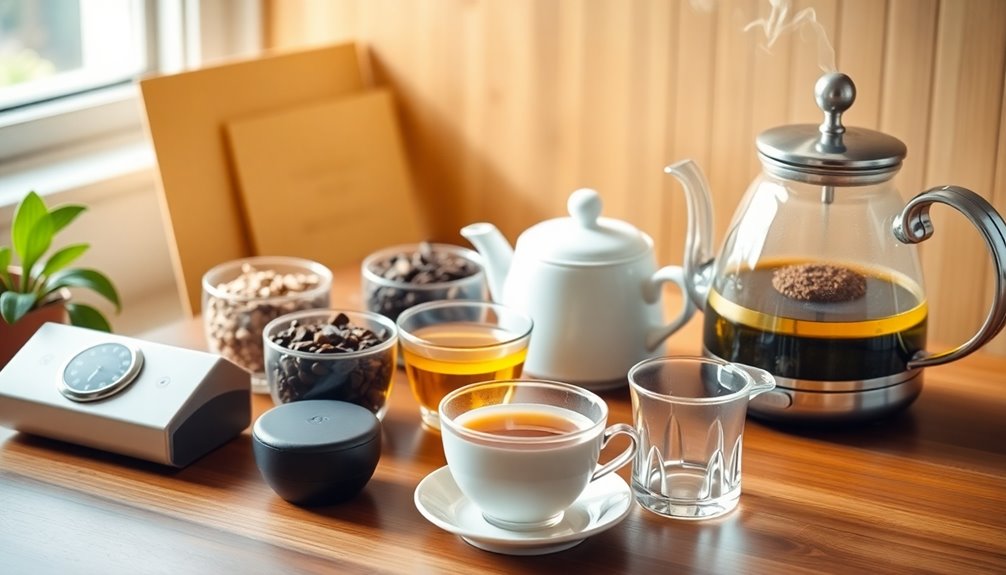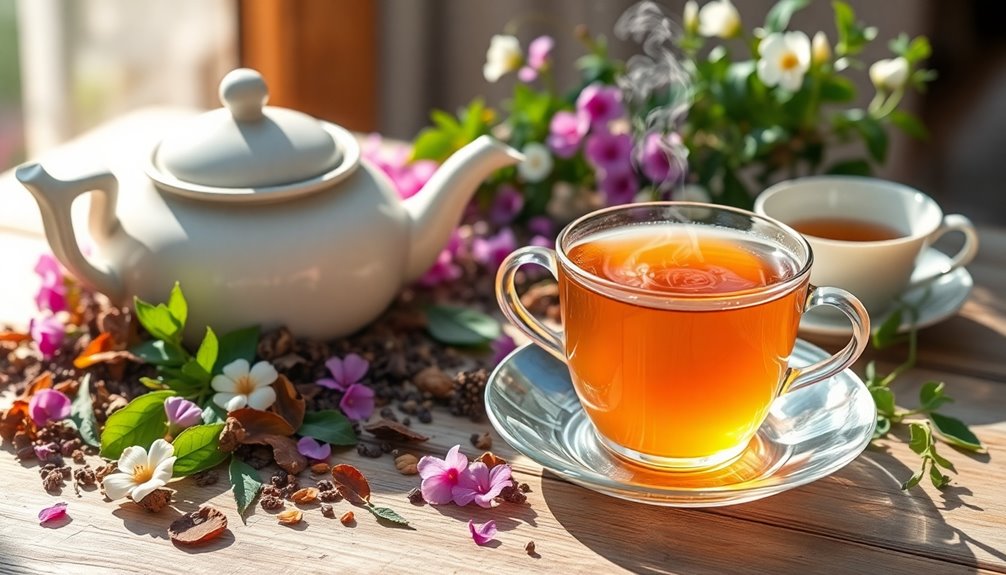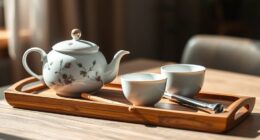To unlock the full flavor of your tea, start with the right temperature! For black tea, heat it to near boiling, while green tea loves cooler water. Next, use filtered or spring water to keep your tea tasting crisp and clean—hard water can be a flavor party pooper! Timing is crucial too; steep most teas for 3-5 minutes, but be gentle with delicate ones, steeping for just 1-3 minutes. Finally, experiment with tea types and tasty herbs to spark your own flavor adventure. Stick around a bit longer, and you'll discover even more secrets to brewing the perfect cup!
Key Takeaways
- Brew black tea with water temperatures between 200°F and 212°F for bold flavors, while green tea requires cooler water around 160°F to 185°F.
- Use filtered or bottled spring water to enhance flavor extraction by removing impurities and unwanted minerals.
- Consider the origin of your tea, as different regions impart unique flavors, like muscatel notes in Darjeeling or earthy tones in Yunnan teas.
- Adjust steeping times according to tea type; delicate teas need 1-3 minutes, while robust teas can steep for 3-5 minutes.
- Experiment with tea-to-water ratios, starting with one teaspoon of loose leaf tea per cup, and try adding fresh herbs for extra flavor.
Introduction
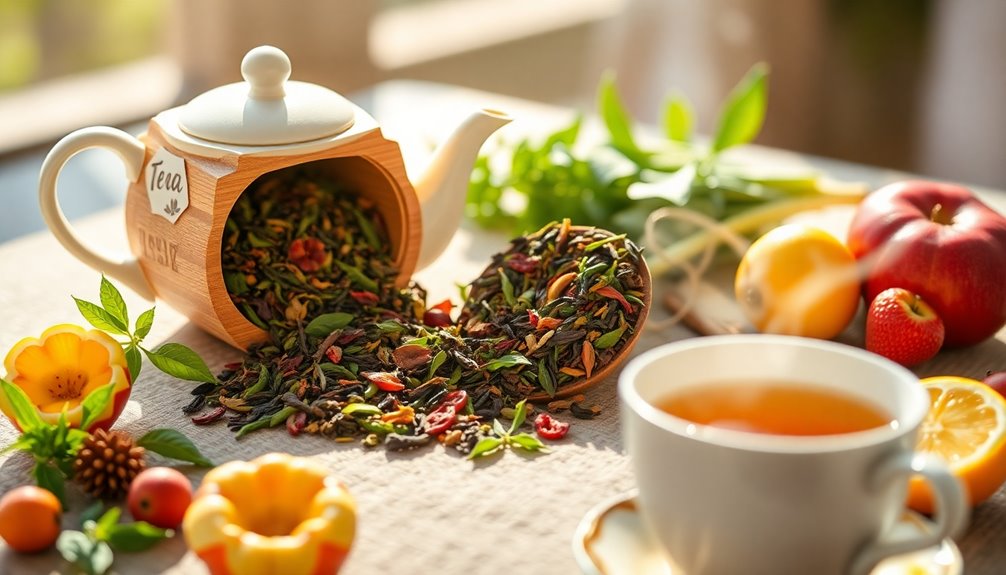
Unlocking the full flavor of your tea is an art that begins with understanding key factors like water temperature and steeping time. When it comes to making the best tea, you'll discover that water temperature is super important! For delicate green teas, you should use water below 176°F to keep them from tasting bitter.
On the flip side, black teas love hot water, which helps pull out their rich, bold flavors.
Now, let's chat about steeping time. Most teas only need about 1-2 minutes to brew, which keeps things from getting too bitter. But if you're using cooler water, you might want to steep your tea a bit longer to really unlock those full flavors.
Don't forget about quality water! Using filtered or bottled water makes a huge difference. It reduces those pesky impurities that can spoil the taste.
As you explore different tea types and blends, you'll find unique flavor profiles waiting for you. Keeping a tea journal can help you remember what you loved or didn't like, making each tea-drinking experience even more enjoyable.
Tea Brewing Temperature Impacts Flavor
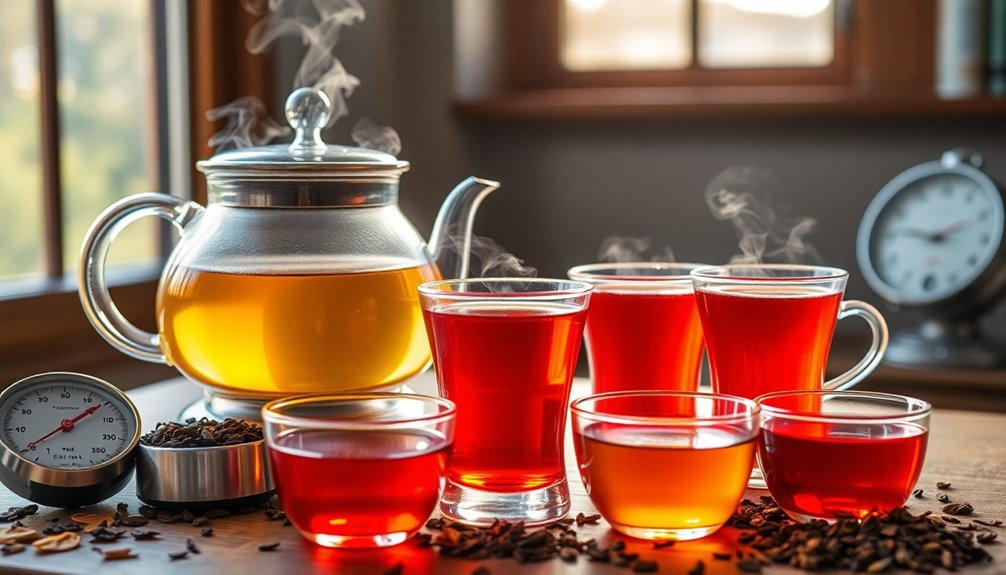
The temperature at which you brew your tea plays a significant role in determining its flavor profile. If you're steeping tea, using the right temperature can make all the difference!
For black tea, you'll want to heat your water between 200°F and 212°F. This hot water helps extract all those rich, bold flavors. But if you're brewing green tea, hold on! You should aim for cooler water, around 160°F to 185°F. Using boiling water can turn your delicate green tea into a grassy or bitter experience, and we definitely don't want that!
Each tea type has its unique brewing needs. Dark teas, like black and pu-erh, thrive in hot water, while green and white teas prefer a gentler touch. Regularly experimenting with different temperatures can help you discover the best flavor extraction for each type of tea.
The fun part is experimenting! Just a slight change in temperature can unlock new flavors. Plus, everyone has their own taste, so don't be afraid to adjust the temperature a bit to suit your preference.
Water Quality Affects Taste
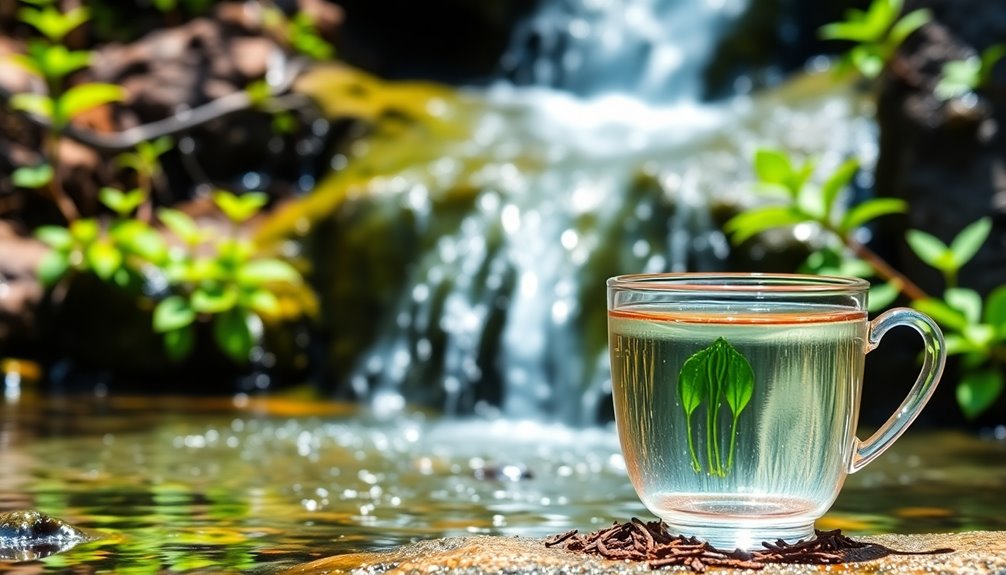
Water quality plays a crucial role in shaping the taste of your tea. If you use hard water, it might add unwanted minerals that dull the tea's natural flavors. Instead, go for filtered water! It removes impurities and chlorine, giving you a cleaner, more vibrant flavor profile. You'll notice the difference right away!
Another great option is bottled spring water. Its balanced mineral content can really enhance your tea's taste, supporting optimal flavor extraction.
Just imagine sipping a delicious cup where all the flavors burst to life! But watch out—using water that's too soft or fully purified could lead to flat-tasting tea. Essential minerals are key to bringing out the best in your brew.
Tea's Origin Influences Flavor
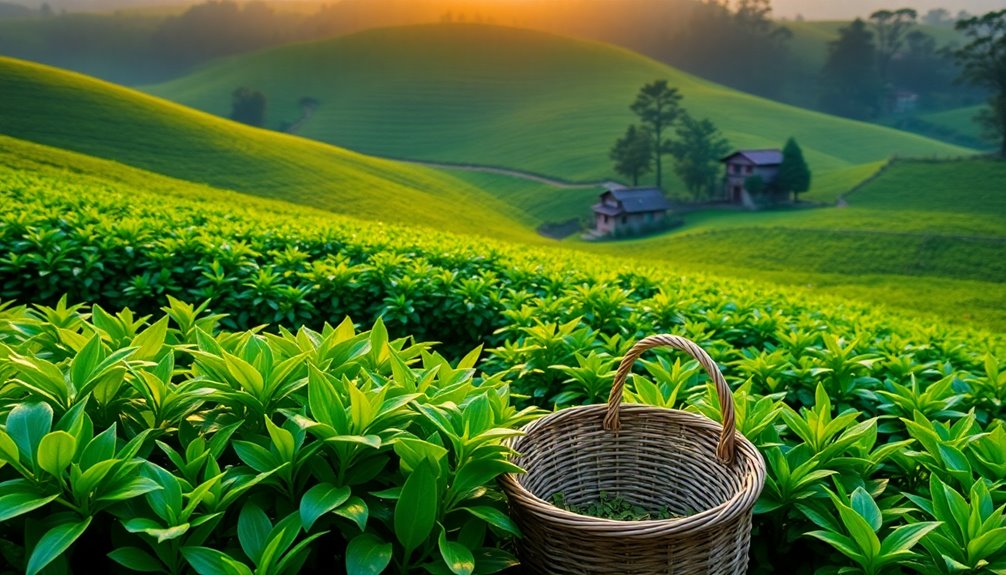
When it comes to enhancing your tea experience, the origin of the leaves plays a significant role in shaping the flavor profile. Each type of tea has its own special taste, influenced by where it comes from and the local climate.
For example, Darjeeling tea from India is famous for its muscatel flavor, thanks to the unique growing conditions in the Himalayan foothills. Isn't that cool?
Chinese teas, like those from Yunnan province, often have earthy and complex flavors due to the rich biodiversity and traditional processing methods in that area.
If you love green tea, Japanese varieties, such as matcha and sencha, offer vibrant, grassy tastes, all because of Japan's specific cultivation techniques and high humidity.
The idea of terroir is important here, just like with wine! It shows how the environment of a tea-growing region can contribute to the final taste and aroma of the tea.
Brewing Time Variability Issues
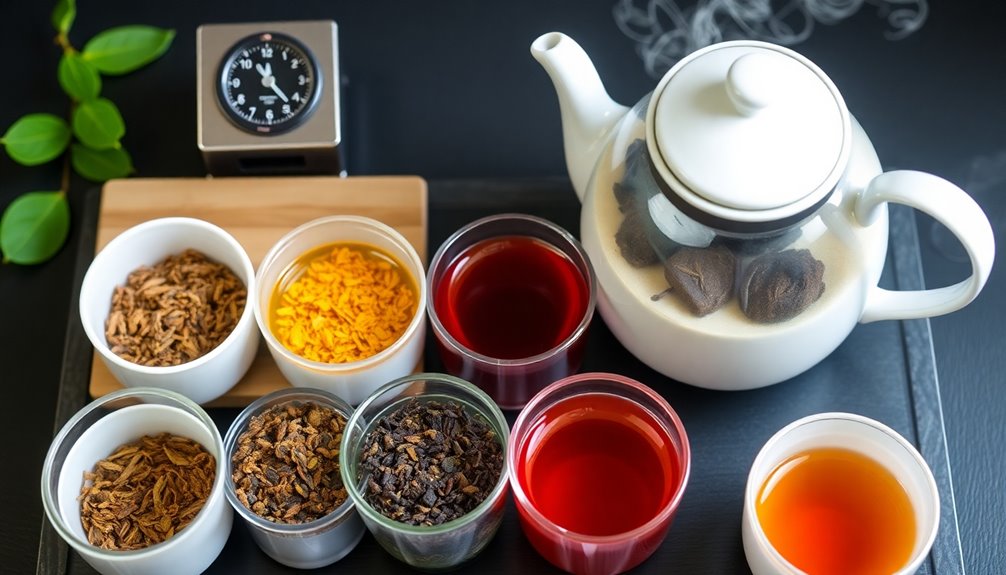
How do you find the perfect brewing time for your tea? It's all about experimenting! Brewing time can really change how your tea tastes. Most teas need to steep for about 3-5 minutes, but watch out! If you leave them too long, you might end up with a bitter cup. This is especially true for delicate teas, like green and white, which should steep for just 1-3 minutes. You want to preserve those light, lovely flavors!
When you shorten the steep times, you can avoid those pesky tannins that make tea taste astringent. Plus, if you over-steep, your tea might taste hollow and not very exciting. Nobody wants that! So, it's super important to pay attention to your brewing time.
Try different steeping times with various tea blends to discover what works best for you. You might prefer a stronger flavor or something a bit milder. Finding the right balance will lead you to the perfect cup, and that's what it's all about!
Practical Applications
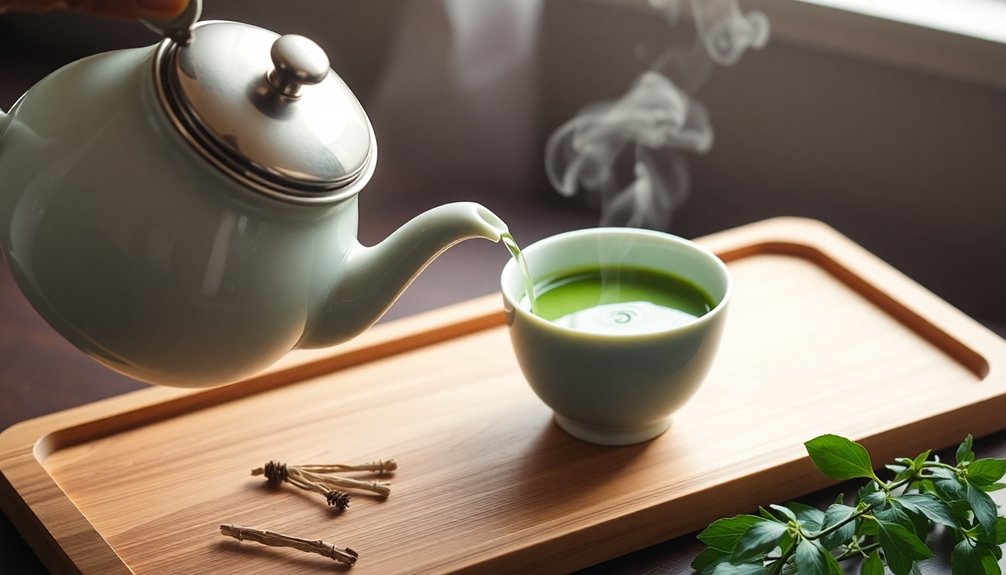
To unlock the full potential of your tea, consider five key practical applications that can significantly enhance your brewing experience.
First, pay attention to the temperature of your hot water. Delicate teas like green and white are best brewed at lower temperatures, under 176°F, so they don't turn bitter. On the other hand, black teas love boiling water for that rich flavor!
Next, adjust your steeping time based on the tea type. Most teas should steep for about 3-5 minutes, but if you're making tea with delicate leaves, a shorter time can help prevent bitterness.
Don't forget about the tea-to-water ratio! A good rule of thumb is one teaspoon of loose leaf tea per cup, but feel free to tweak it based on your taste.
For a fun twist, try adding fresh herbs like mint or basil—just one teaspoon per cup will elevate the flavor without making it sweet. Additionally, experimenting with brewing techniques can lead to even richer flavors, especially when using rooibos tea.
Finally, use filtered water to keep impurities at bay, ensuring your steeped tea tastes its very best.
With these simple techniques, you'll be on your way to enjoying delicious cups of tea every time!
Frequently Asked Questions
How to Get the Most Flavor Out of Your Tea?
To get the most flavor out of your tea, experiment with water temperature and steeping time, use quality filtered water, and pay attention to the aroma. Adjust your tea-to-water ratio based on personal preference.
What Is the Tea Technique?
The tea technique involves mastering brewing methods, like adjusting water temperature and steeping time, to enhance flavor. You can experiment with ratios, pre-warm your teapot, and keep a journal to track your experiences.
How Can I Make My Tea Taste Better?
To make your tea taste better, try adding lemon for brightness, fresh fruits for sweetness, or warming spices like ginger. Using filtered water and fresh herbs can also enhance the flavor and overall experience.
Why Can't I Taste the Flavor in My Tea?
You can't taste the flavor in your tea due to recent strong foods or cold symptoms affecting your palate. Also, poor water quality, incorrect tea amounts, or improper brewing temperature might be dulling your experience.
Conclusion
Now that you know how to unlock the delightful flavors of tea, it's time to put your skills to the test! Remember, the right temperature, good water, and knowing where your tea comes from can make a big difference. Don't forget to play with brewing times to find your perfect cup! So grab your favorite tea, invite a friend, and enjoy a delicious adventure in every sip. Happy brewing, and may your tea be as bright as your smile!

